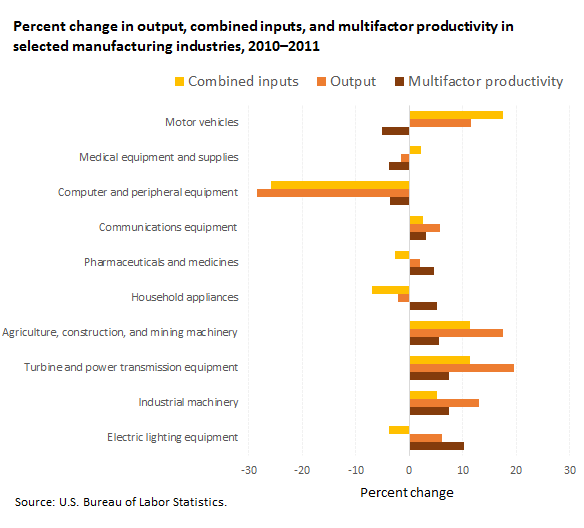An official website of the United States government
 United States Department of Labor
United States Department of Labor
Multifactor productivity—defined as output per unit of combined inputs—increased in 55 of the 86 four-digit NAICS manufacturing industries in 2011.

| Manufacturing industry | Combined inputs | Output | Multifactor productivity |
|---|---|---|---|
Motor vehicles | 17.6 | 11.6 | -5.1 |
Medical equipment and supplies | 2.2 | -1.6 | -3.8 |
Computer and peripheral equipment | -25.9 | -28.5 | -3.6 |
Communications equipment | 2.5 | 5.7 | 3.1 |
Pharmaceuticals and medicines | -2.6 | 2.0 | 4.7 |
Household appliances | -6.9 | -2.1 | 5.1 |
Agriculture, construction, and mining machinery | 11.4 | 17.5 | 5.5 |
Turbine and power transmission equipment | 11.3 | 19.6 | 7.4 |
Industrial machinery | 5.2 | 13.1 | 7.5 |
Electric lighting equipment | -3.7 | 6.2 | 10.3 |
Three manufacturing industries recorded double-digit percent increases in multifactor productivity: semiconductors and electronic components, other transportation equipment, and electric lighting equipment.
Increases in output were particularly large in turbine and power transmission equipment; metalworking machinery; agriculture, construction, and mining machinery; railroad rolling stock; and audio and video equipment. Multifactor productivity rose in each of those industries. Output declined the most in computer and peripheral equipment and in apparel knitting mills.
Multifactor productivity indexes relate the change in real output to the change in the combined inputs of labor, capital, and intermediate purchases consumed in producing that output. Multifactor productivity growth measures the extent to which output growth has exceeded the growth in inputs, and reflects the joint influences on economic growth of a variety of factors that are not specifically accounted for on the input side, including technological change, returns to scale, enhancements in managerial and staff skills, changes in the organization of production, and other efficiency improvements.
These data are from the Productivity program. To learn more, see "Multifactor Productivity Trends for Detailed Industries — 2011" (HTML) (PDF), news release USDL-13-1941.
Bureau of Labor Statistics, U.S. Department of Labor, The Economics Daily, Multifactor productivity for manufacturing industries, 2011 at https://www.bls.gov/opub/ted/2013/ted_20130930.htm (visited May 23, 2024).

